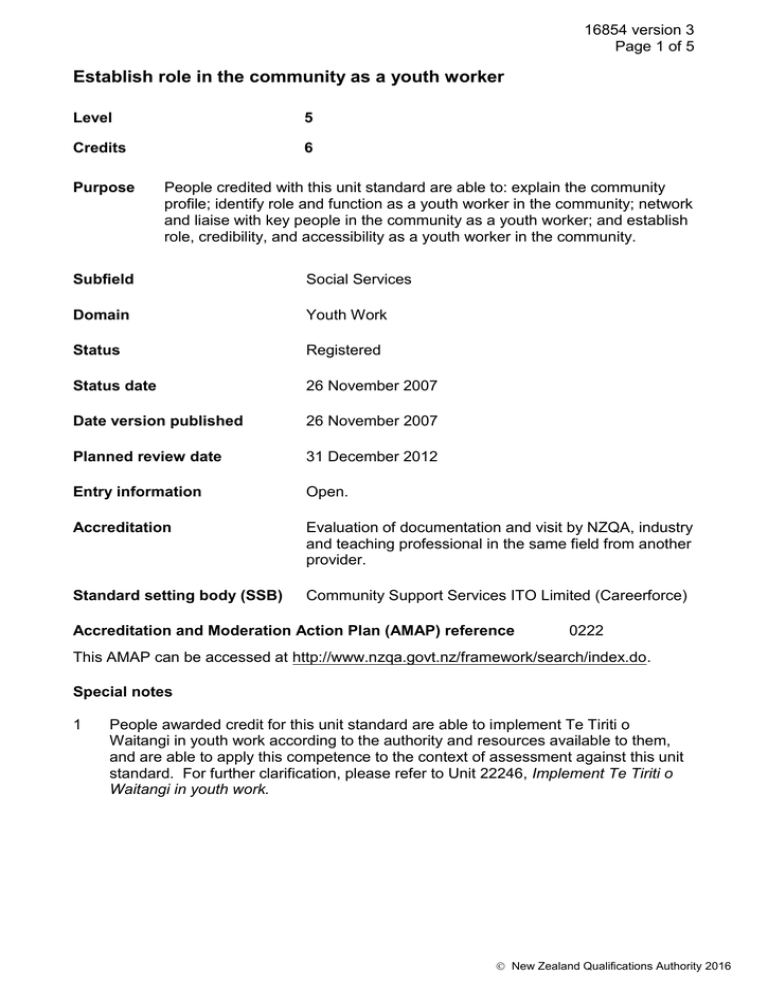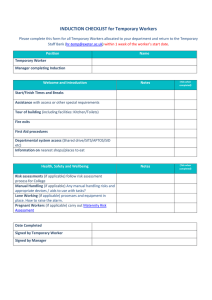Establish role in the community as a youth worker
advertisement

16854 version 3 Page 1 of 5 Establish role in the community as a youth worker Level 5 Credits 6 Purpose People credited with this unit standard are able to: explain the community profile; identify role and function as a youth worker in the community; network and liaise with key people in the community as a youth worker; and establish role, credibility, and accessibility as a youth worker in the community. Subfield Social Services Domain Youth Work Status Registered Status date 26 November 2007 Date version published 26 November 2007 Planned review date 31 December 2012 Entry information Open. Accreditation Evaluation of documentation and visit by NZQA, industry and teaching professional in the same field from another provider. Standard setting body (SSB) Community Support Services ITO Limited (Careerforce) Accreditation and Moderation Action Plan (AMAP) reference 0222 This AMAP can be accessed at http://www.nzqa.govt.nz/framework/search/index.do. Special notes 1 People awarded credit for this unit standard are able to implement Te Tiriti o Waitangi in youth work according to the authority and resources available to them, and are able to apply this competence to the context of assessment against this unit standard. For further clarification, please refer to Unit 22246, Implement Te Tiriti o Waitangi in youth work. New Zealand Qualifications Authority 2016 16854 version 3 Page 2 of 5 2 Glossary: Characteristics and needs of youth may be physical, spiritual, or mental. Characteristics include: age and stage of development, coping strategies, culture, disabilities, experience and knowledge, gender, health status, personal history, language, sexual orientation, socio-economic situation, risk and resiliency factors. Needs include physical comfort, safety, and privacy. Community may include but is not limited to: a community of interest, a community of locality, a cultural community, a youth culture, or a kin group. People awarded credit for this unit standard demonstrate competence in one context. Concern, issue, or need may include but is not limited to: abortion, contraception and pregnancy; alcohol and drug issues; alternative care; community issues; consumer rights; criminal justice; disabilities; economic development; education and training; employment; environmental issues; families and whānau; health care; housing and land; human rights; iwi development; legal issues; parenting; psychiatric care; sexuality; social security benefits; social policy; structures; sport and recreation; violence and abuse. The focus may be cultural, emotional, psychological, physical, spiritual, social, or political factors, or may be related to age, gender, or sexual orientation. Key people include but are not limited to: people within a family or whānau, hapū, iwi, group, agency, or organisation who are given the authority or mana to speak on behalf of those people by virtue of their position, expertise, or knowledge. It is expected that where a community of locality is the focus, key people will include those identified from a cross section of individuals and organisations that provide services to the community of locality. Where youth cultures are concerned, key people include established youth leaders in the community and members of the youth cultures. Nature of the community may be determined by reference to factors that include but are not limited to: the age and stage of development, cultures, disabilities, gender, health status, interests, kin relationships, language, sexual orientation and/or socioeconomic status of the members of the community. Organisational guidelines include but are not limited to: mission statement; kaupapa; vision and objectives; policies and procedures; job descriptions; legislation; codes of conduct; rules and guidelines of the organisation; code of ethics. Youth culture includes but is not limited to any culture a young person identifies with. Sub-culture includes any group of youth who are self-identified as a sub-culture or sub-group and may include but is not limited to: skaties; gothics; hip hop; gangs; boguns; boy/girl racers; computer nerds; academics; gamers; ravers; church groups; sporting and recreational groups; uniform groups. 3 Assessment notes: People awarded credit for this unit standard demonstrate competence in one youth work context, with any combination of concerns, issues, and needs of youth. New Zealand Qualifications Authority 2016 16854 version 3 Page 3 of 5 4 All communications are treated confidentially. The scope and limits of confidentiality are defined through negotiation and informed consent, and criteria established by legislation, ethical practice, and youth work agency guidelines. In the context of this unit standard, sources of criteria established by legislation, ethical practice, and youth work agency guidelines include but are not limited to: Official Information Act 1982, Privacy Act 1993, youth work agency codes of conduct, codes of practice issued by the Privacy Commissioner, youth work codes of ethics, and youth work agency protocols, staff manuals, strategic plans. Relevant additional legislation and the codes of conduct, and youth work agency guidelines will be determined according to the context of assessment. 5 Resources: a Ministerial Advisory Committee on a Māori perspective for the Department of Social Welfare. 2001 Reprint. Puao-Te-Ata-Tu (day break) – The report of the Ministerial Advisory Committee on a Māori perspective for the Department of Social Welfare. Wellington: Department of Social Welfare. Available online from the Department of Child, Youth and Family Services (http://www.cyf.govt.nz/Reports.htm) and the Ministry of Social Development (http://www.msd.govt.nz/publications/p-t.html). b Ministry of Youth Affairs. 2002. Youth development strategy Aotearoa – Action for child and youth development. Wellington: Ministry of Youth Affairs. Available online from the Ministry of Youth Development (http://www.myd.govt.nz), along with supporting documents. c United Nations Declaration of the Rights of the Child and Convention on the Rights of the Child, which may be found online at: http://www.unhchr.ch/html/intlinst.htm http://www.unicef.org/crc/. Elements and performance criteria Element 1 Explain the community profile. Performance criteria 1.1 The profile of the community is explained in terms of statistics on age, ethnicity, and socio-economic status. Range 1.2 statistics may include but are not limited to – census; local or regional government statistics; youth network statistics; youth work agency statistics. Evidence is required using one set of currently available statistics. The profile of the community is explained in terms of valid and current sources of information on youth cultures and youth services in the community. Range evidence is required on two youth cultures or sub-cultures, and four youth services. New Zealand Qualifications Authority 2016 16854 version 3 Page 4 of 5 Element 2 Identify role and function as a youth worker in the community. Performance criteria 2.1 Boundaries of the youth worker's role and function in the community are described according to the job description or contract as a paid or unpaid youth worker. 2.2 Boundaries of the youth worker's role and function in the community are described according to accountability to the supervisor and peer group. 2.3 Boundaries of the youth worker's role and function in the community are described according to the concerns, issues, and needs of youth in the community. 2.4 Boundaries of the youth worker's role and function in the community are described according to criteria established by legislation, ethical practice, and organisational guidelines. Element 3 Network and liaise with key people in the community as a youth worker. Performance criteria 3.1 Networking and liaison needs are identified according to personal, youth work agency, and professional requirements and priorities. Range requirements and priorities may include but are not limited to – accountability, advice, credibility, information, role clarity, service provision, professional support. Evidence is required of four requirements and priorities. 3.2 Networks and key people in the community are identified according to relevance to the youth worker's role, the priorities of the youth work agency, and the youth worker's target groups. 3.3 Networking and liaison within the community are established according to identified networking and liaison needs. Element 4 Establish role, credibility, and accessibility as a youth worker in the community. Performance criteria 4.1 Personal and professional roles and functions as a youth worker are established according to identified boundaries. New Zealand Qualifications Authority 2016 16854 version 3 Page 5 of 5 4.2 Personal and professional roles and functions as a youth worker are distinguished from the roles and functions of other social service workers in the community. 4.3 Role, credibility, and accessibility are established in the community according to the judgement of key people in the community. 4.4 Personal and professional performance in the youth worker's role and function match the characteristics and needs of the youth worker's target groups. Range personal and professional performance in the youth worker's role and function may include but is not limited to – ability to relate to difference as evidenced by acknowledgement and respect for difference; acceptance; accountability; adaptability; ethical behaviour; being genuine; honesty; humility; openness; patience; self-awareness; sensitivity; trust and safety with youth; warmth. Evidence is required of four examples of personal and professional performances that meet target groups' needs. Please note Providers must be accredited by NZQA, or an inter-institutional body with delegated authority for quality assurance, before they can report credits from assessment against unit standards or deliver courses of study leading to that assessment. Industry Training Organisations must be accredited by NZQA before they can register credits from assessment against unit standards. Accredited providers and Industry Training Organisations assessing against unit standards must engage with the moderation system that applies to those standards. Accreditation requirements and an outline of the moderation system that applies to this standard are outlined in the Accreditation and Moderation Action Plan (AMAP). The AMAP also includes useful information about special requirements for organisations wishing to develop education and training programmes, such as minimum qualifications for tutors and assessors, and special resource requirements. Comments on this unit standard Please contact the Community Support Services ITO Limited (Careerforce) info@careerforce.org.nz if you wish to suggest changes to the content of this unit standard. New Zealand Qualifications Authority 2016


